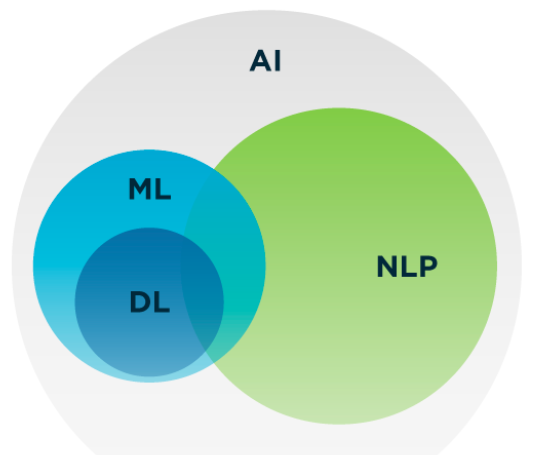AI/ML/NLP – Terms and Definitions
In recent years, Artificial Intelligence (AI), Machine Learning (ML), and Natural Language Processing (NLP) have been highly topical subjects within all the major industries. We can view them as a new standard set in research, development, and engineering of up-to-date technical solutions.
Occasionally, these three terms are interchangeable. However, there is a distinct difference between them. Artificial intelligence is an encompassing or technical umbrella term for those smart machines that can thoroughly emulate human intelligence. Natural language processing and machine learning are both subsets of artificial intelligence.
Artificial Intelligence
Intelligence itself is one’s capacity for logic, understanding, self-awareness, learning, emotional knowledge, planning, creativity, and problem-solving. Artificial Intelligence is the broader concept of endowing machines with intelligence (emotional / social / logical intelligence, planning, creativity, etc.). AI facilitates computer systems to solve challenges previously managed by biological systems only.
Machine Learning
Machine Learning is a subfield of AI. This is a way to implement decision-making in AI. ML is an application of artificial intelligence that helps computer systems to learn and improve from their experiences without being explicitly and automatically programmed to do so. A subset of Machine Learning and the most effective of all the machine learning algorithms is Deep Learning (DL).
A major breakthrough that led to the emergence of Machine Learning as the driving force behind AI is the invention of the Internet. This global network came with a huge amount of digital information being generated, stored, and made available for analysis. Currently, both structured and unstructured data is gathered from myriad sources. ML algorithms learn from this data as from a training set to fine-tune parameters of models/algorithms and develop their own “intelligence”.
Natural Language Processing
The term Natural Language Processing refers to the technical branch of computer science, or artificial intelligence. It is concerned with providing computer systems with the ability to understand text or voice messages – in much the same way that human beings can accomplish.
NLP combines computational linguistics and rule-based modeling of human language with statistical approach and deep learning models. These technologies enable computers to process human language (in the form of text or voice messages) and understand its full meaning. Such an understanding is combined with the intent and sentiment of the writer or speaker. With NLP, machines can assemble the meaning of the spoken or written text, perform speech recognition tasks, emotion analysis, and automatic text summarization.
AI/ML/NLP in Our Everyday Life
There are many examples of Artificial Intelligence, Machine Learning, and Natural Language Processing at work in our world today. However, too often people aren’t even aware of it. These technologies help both individuals and organizations to analyze their data, uncover new insights. Equally important that they are able to automate time and labor-consuming processes, facilitate decision-making, and bring competitive advantages.
For example, every time you do a web search, when Netflix recommends a movie, when Facebook selects posts, when Amazon recommends a book, Machine Learning is behind.
Natural language processing operates within computer programs to perform the following tasks in real-time processing boundaries:
- translate digital text from one language to another
- respond appropriately and sensibly to spoken commands
- summarize large volumes of information.
More than likely you have already had interaction with NLP. It is widely used in the form of voice-guided GPS car systems, personal digital assistants, dictation software using speech-to-text algorithms. In addition, it forms the basis for customer service online chatbots and other consumer amenities.
Commercialization of AI/ML/NLP
A powerful trio of technologies – Artificial Intelligence, Machine Learning, and Natural Language Processing – has only commenced its commercialization journey within industries and business operations. The following examples are just a few of the most common commercial applications in some of the largest industries globally:
- HR management
Automation of processes, productivity improvement, reduction of operational costs and business risks, accurate personality assessment, delivery of unbiased hiring decisions, building of the most effective teams ever. Enhancing of employee satisfaction and company-to-employee relationships, value adding, gaining of competitive advantages. - Insurance
Deep analysis of customer personality and communication data for identification of potentially fraudulent claims. Utilizing text mining and market intelligence features for “reading” of competitors and subsequent planning of own products and services. - Credit Institutions
Borrowers’ credibility monitoring and personality assessment for detection of potential risks of default or late payments. Getting insights to design new business models including marketing and pricing strategies. - EdTech
Generation of comprehensive vocational profiles of individuals, including personality traits and vocational/avocational interest for invention of future-oriented and economically feasible educational models and better vocational guidance. Selection of career pathways meeting the full potential of people. - Migrant Integration
Analysis of educational background, skills, personality traits, and pre-migration success story for better migrant integration in a host country and provision pathways into successful careers. - Healthcare and Medical
Quick and accurate summarizing, categorization, logging and utilizing of patient information based on significant medical keywords for improvement of diagnosis accuracy, medical treatment, life quality and life expectancy. - FinTech
Multi-faceted analysis for leveraging real-time market insights, making informed investment decisions, and improvement of risk management activities. Identification of money laundering activities or other fraudulent circumstances. - Manufacturing and Supply Chains
Analysis of vast shipment data arrays and delivery of deeper insight into supply chain points that require particular attention, logistical modifications, and efficiency optimization. “Web scraping” for resources and information about industry benchmark values for transport rates, fuel prices, and skilled labor costs for identification of cost-saving opportunities. - Consumer Retail
Deep consumer sentiment analysis, assessment of customer opinion and emotions towards brands and delivery of meaningful customer experience data for brand strengthening and customer loyalty improvement.
You can get more information from the “Use Cases” section of this website.

